Header logo
header top contact widget
Sore or swollen gums
Are YOU One Who Is More Likely To Have Gum Disease?
Posted on Dec 10, 2020 by William J. Claiborne, DDS MS
As a periodontist, I have a pretty unique view of the inside of a mouth.
In my specialty, we are particularly focused on the condition of the gum tissues in the mouth, or “periodontal” tissues. We are specially trained to treat all stages of gum disease and in the diagnosis and placement of dental implants.
A periodontal specialist is also trained in performing esthetic procedures that involve gum tissues, such as crown lengthening and correcting a “gummy smile”.
To clarify, a periodontist is a dentist who extends his or her education and skills further (typically 3 years past completing dental school) to specialize in the prevention, diagnosis, and treatment of periodontal disease and other gum conditions.
1). THE NATURAL AGING PROCESS
Although we treat patients of all ages, there are certain segments of the population we see more often. For instance, a large segment of our patients are age 50 and older. In addition to having more susceptibility to have gum disease, many in this age group have lost teeth.
In a recent report by the Centers for Disease Control & Prevention (CDC) on data related to prevalence of periodontitis in the U.S.: over 47% of adults ages 30 years and older have some form of periodontal disease. For adults 65 years and older, that number rises to over 70%.
This is because the aging process causes the body begins to succumb to wear and tear. The skin sags, bones weaken, joints ache, hearing dulls, and eyesight wanes. This means that more precautions and measures are needed to keep the teeth and gum tissues in good shape.
In addition to healthy gums, it’s important to keep your natural teeth as you age. Natural teeth to support neighboring teeth and provide stimulation to the jaw bone is unsurpassed.
Having the ability to comfortably and efficiently bite and chew is vital to having a healthy body. When dentures or partials compromise the ability to eat a diet of healthy foods – and chew food properly – gastrointestinal problems are common.
Although dental implants are excellent replacements for missing teeth, there is nothing as perfect as your “permanent” teeth.
There are a number of reasons why seniors face more oral challenges, including:
• A dry mouth: The tissues inside the mouth need to be kept moist. Saliva is designed to do this. However, with age, the flow of saliva becomes less plentiful. Just as the skin and hair get drier with age, the mouth undergoes this as well. When saliva flow is less efficient at rinsing bacteria from the oral cavity, bacteria grow at a more rapid rate. This allows bacteria accumulation to occur more frequently than twice-a-day brushing can control.
• Reduced ability to maintain at-home oral hygiene: Aging causes the fingers to be less nimble and stiffens joints. This is a particular challenge when it comes to brushing and flossing. Angling a toothbrush to reach all areas in the mouth and proper flossing maneuvers require manual dexterity that are more difficult due to the natural aging process.
• Medication side effects: The average American adult in the 65-79 age group has over 27 prescriptions filled each year. (https://www.statista.com/statistics/315476/prescriptions-in-us-per-capita-by-age-group/). Although you may need these medications, keep in mind that some can be detrimental to your oral health. This is why it’s important to provide a complete list of all medications you take (including vitamins and herbal supplements) at every dental appointment so your dentist can adjust care to your specific needs.
• Hormonal changes: Due to declining estrogen levels, post menopausal females have a higher risk for gum disease and subsequent tooth loss. This causes an increased risk of bone loss or osteoporosis as well as inflamed gum tissues around the teeth (called periodontitis). When there is a decline in jaw bone mass, it can result in tooth loss.
Bacteria overgrowth in the mouth is the cause of gum disease. Periodontal disease is the nation’s leading cause of adult tooth loss. Its bacteria can also enter the bloodstream, causing inflammatory reactions far beyond the mouth.
Advanced gum disease bacteria has been linked to a number of serious health problems. These include heart disease, stroke, high blood pressure, diabetes, arthritis, memory loss, some cancers, impotency and Alzheimer’s disease.
Obviously, maintaining healthy gums and keeping your natural teeth is important. If you’ve experienced tooth loss, we can replace them with dental implants. These are the closest thing to the natural teeth you had and will restore stability and dependable biting and chewing.
At any age, the goal is to keep bacteria levels in the mouth to the lowest level possible. When oral bacteria are allowed to accumulate, it can lead to Gingivitis. This is an early stage of gum disease. As it progresses, periodontal disease continually worsens. Eventually, it becomes periodontitis, which is an advanced level of gum disease.
Although gum disease can exist without obvious signs or symptoms, the most commonly noticed are:
• Red, swollen or tender gums
• Seeing blood in the sink when brushing
• Receded gums • Loose or separating teeth
• Pus pockets on gum tissues
• Sores in the mouth
• Persistent bad breath
2). ADULTS WITH DENTAL FEAR
Another large segment of our patients are those who have avoided dental care for years, often due to having dental fear.
One study, published by StudyFinds.org, shares recent findings of 2,000 adults in the U.S. regarding dental visits. Results show a whopping 62% of those surveyed stating they were too afraid to even visit a dentist’s office. (https://www.studyfinds.org/adults-too-scared-visit-dentist-teeth/)
If dental fears or anxiety have kept you from regular dental checkups for a year or more, it would be rare to NOT have some level of gum disease. Quite frankly, some people with high fear levels avoid seeing a dentist for decades. Those visits are vital in one’s ability to have healthy gums.
While twice daily brushing and daily flossing are necessary components for having good oral health, the routine alone isn’t enough to combat a number of additional factors that make one vulnerable to the disease.
For example, a study by Delta Dental revealed, only 7 out of 10 adults are brushing twice a day. This means that 30% aren’t brushing enough. (https://www.ada.org/en/publications/ada-news/2014-archive/october/survey-finds-shortcomings-in-oral-health-habits)
3). PREGNANCY
We also see a number of moms-to-be. For decades, the Surgeon General has warned that pregnant females who had gum disease had a far greater risk of a pre-term, low birth weight baby. Research has shown that gum disease increases the risk for pre-term delivery (prior to 37 weeks) and low birth weight babies (less than 5.5 lbs.).
“Studies have found that expectant mothers with periodontal disease are up to seven times more likely to deliver premature, low birth weight babies.” (https://www.adha.org/resources-docs/7228_Oral_Health_Total.pdf) One study showed the preterm birth rate for pregnant women with moderate to severe periodontal disease to be nearly 29%.
Estimates are that over half of pregnant women have some form of gingivitis (gum inflammation, an early stage of gum disease) or periodontitis (infectious, advanced gum disease). Nearly a third of pregnant females will acquire gum disease because of their higher vulnerability to inflammation.
When these indications exist, it is important to seek periodontal treatment as soon as possible. Gum disease only worsens without treatment, requiring more time and expense to rid this serious, even deadly, inflammatory disease.
4). ALL ADULTS
Regardless of age or health status, oral wellness has always been important to overall health. Without good gum health, there is a greater drain on the body’s immune system. This is now even more important than ever, due to COVID and the flu season upon us.
Remember, even a twice-daily brusher and daily flosser does not mean you will avoid gum disease. Avoiding regular dental check-ups is a sure recipe for needing treatment down the road that may have easily been prevented.
In our Asheville periodontal dental office, patients can begin with a consult in our private consultation room that’s removed from the clinical side of the practice. We are always happy to discuss oral health options with new patients. A referral is not needed.
Call 828-274-9440 to schedule.
How To Avoid Gum Disease & Cavities From Sugar This Holiday
Posted on Nov 12, 2020 by William J. Claiborne, DDS MS
Regardless of size and distancing limitations on 2020 holiday gatherings, you can bet that Americans will still consume the yummy indulgences associated with the season. After all, we all need comfort food these days. The holidays simply give us “justification” for eating the sugary, rich treats we’ve waited all year to enjoy. We release the guilt and know we’ll pay for it through our new year’s resolutions.
I’m the last person on earth who would preach abstinence when it comes to things like thick egg nog, sugar cookies and pecan pie. Like you, I wait all year to savor things like this. However, I’m also a periodontist and have a unique look at what this added sugar can do to teeth and gums.
Keep in mind that all food (as well as beverages other than plain water) cause an acidic surge into the mouth. This is sent in via saliva and is the first stage of the digestive process. This acid is so strong it can actually soften tooth enamel for 20-30 minutes, leaving you with a higher risk for tooth decay.
Sugar also super-charges oral bacteria, which are living, eating and breeding organisms. They thrive in colonies as they subsist on gum tissues. As bacteria levels grow, the gums become inflamed. This is the first stage of periodontal (gum) disease.
As gum disease worsens, the inflammation caused by these bacteria can lead to persistent bad breath, receded gums that expose sensitive tooth roots, and gums that darken in color. If untreated, pus pockets can eventually form at the base of some teeth and attack the tooth supporting structures beneath the gums.
Eventually, teeth will loosen and can require removal. Also known as periodontal disease, this is the nation’s leading cause of adult tooth loss.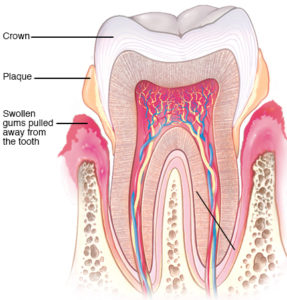
Even without the holidays, Americans are the biggest sugar consumers on earth. Although the World Health Organization (WHO) recommends no more than 5% of daily sugar intake, or less than 25 grams, Americans consume 82 grams each day, on average. That translates into over 19 teaspoons of sugar per day and 66 pounds each year, per person.
When researchers from the University College London & London School of Hygiene studied public health records from around the world, they found that 92% of American adults have cavities. Compare this to Nigeria, a country with a diet very low in sugar, where only 2% of the population have had tooth decay. Also concerning were their findings that nearly 90% of America’s school age children have experienced tooth decay.
Childhood obesity is also out of control. The Centers For Disease Control & Prevention (CDC) reports that the U.S. percentage of children with obesity “has more than tripled since the 1970s. Today, about one in five school-aged children (ages 6–19) has obesity.” That’s nearly one-third of children who are overweight or obese. https://www.cdc.gov/healthyschools/obesity/facts.htm Obesity is when fat content of the body is over thirty percent of its overall mass.
According to the Centers For Disease Control & Prevention (CDC), adults in the U.S. who are categorized as obese is at nearly 40 percent. Another 30 percent are categorized at overweight.
While sugar is not the only culprit, Americans have been lured into a lifestyle surrounded by sugary snacks and beverages. (After all, ads tell us that we need to grab a Snickers bar, not an apple, as an afternoon pick-me-up.)
You may be surprised to know that studies show that sugar is even addictive. It activates the same regions in the brain that react to cocaine. (https://www.brainmdhealth.com/blog/what-do-sugar-and-cocaine-have-in-common/)
How does this apply to your smile? Research has shown that obese adults have a 6 times higher potential to develop periodontal (gum) disease. As a periodontal specialist, my goal is always to help patients achieve optimal oral health. In our Asheville periodontal dental office, we address the risks of periodontal disease with our patients without judgement of their weight, but rather how we can help them enjoy a healthier smile.
As difficult as losing weight can be, it is important to be aware of risk factors that can make you more susceptible to gum disease. Initial symptoms include gums that are tender, swollen, and may bleed when brushing. This stage, known as gingivitis, is actually reversible with prompt, thorough oral hygiene.
This holiday, try to reduce your intake of sugar and carbohydrates. This will help to lower your potential for damage by oral bacteria, reducing your risk for cavities and gum disease. Additionally, be committed to a thorough at-home routine of daily flossing, twice a day brushing and drinking plenty of water.
If you are experiencing symptoms of gum disease, however, it is important to be seen by a periodontist as soon as possible to halt further progression. A periodontist is a dental specialist who has advanced training in treating all stages of gum disease as well as in the placement of dental implants. The earlier the treatment, the less involved treatment requirements will be. Gum disease will not improve without professional care.
Call 828-274-9440 to schedule an initial examination or begin with a consultation.
Contour Of Gums Affect Smile’s Appearance & Tooth Health
Posted on Oct 21, 2020 by William J. Claiborne, DDS MS
A periodontal specialist is your dental ‘expert’ in diagnosing and treating all stages of periodontal (gum) disease and in the selection and placement of dental implants.
Bringing an advanced level of expertise to these areas, that often need complex treatment, provides patients with a higher potential for outcomes with ideal comfort in minimal treatment time.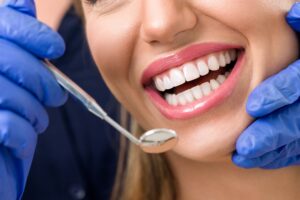
A particular skill that a periodontist also has is in the reshaping of the gums that surround teeth. There are several reasons that gum re-contouring is advantageous, including enhancing the appearance of a smile and even saving a tooth from removal.
The gum tissues are designed to provide a tight seal around the base of teeth where to block out bacterial entry to the sensitive tooth root area. When oral bacteria is able to penetrate beneath the gum line, these bacteria can cause inflammation to tender gums and attack the structures that support natural teeth. Obviously, it’s important to ensure the gums are healthy so the grip they have around teeth is snug.
In addition to the effect of bacteria that can loosen gum tissue, gums can pull away from the base of teeth due to the aging process. As we get older, our tissues are less supple and drier. Too, when people use a hard-bristle tooth brush or are over-zealous in brushing (using a ‘scrubbing’ motion), it can wear away precious gum tissues. Although this action is often done in an effort to do a “really good job” when brushing teeth, it is actually detrimental in the long run. (Use a circular motion on the front and back of teeth and a swirling motion along the tops.)
A procedure known as a gingivectomy can reposition or graft gum tissues over the area of recession to restore a healthy seal and protect the tooth structures below the surface.
Another advantage a periodontist can provide can help to save a natural tooth. When a tooth breaks near the gum line, a crown lengthening procedure may be advised. In this, a periodontist may be able to expose enough of the tooth structure for the placement of a crown.
In addition to protecting and saving teeth, gum contouring is also performed to create a more beautiful smile. This, too, is through a gingivectomy. It is ideal when there are different heights of gum tissues framing the teeth most visible in a smile. This tends to create a jumbled looking smile, when when the teeth are straight.
To illustrate this, imagine walking into a room that has 4 windows. While the windows are of a similar size, the balance of the room’s appearance would be ‘off’ it each window had a different curtain height. Let’s say one window had a large valance above it that rose to the ceiling, another had a small ruffle at the top of the window, another had no panel at all, and the other had a 6-inch flat panel.
Having a similar arch of gums over each tooth is an important part of a smile’s appearance. It creates a balance that complements teeth.
A gingivectomy is also performed for people who wish to correct a “gummy smile.” This is when too much gum tissue is visible above all upper teeth in a full smile. A periodontist can use his or her specialized skills to reshape the tissues to provide a more balanced smile line. In our office, we utilize a dental laser. This provides a precision line of contouring gum tissues and seals as it goes. This means that there is minimal bleeding and healing time is reduced.
This procedure is typically combined with the placement of crowns to protect the exposed sections of the teeth. The results are a natural look, a healthy smile, and a smile that is shared often!
Another procedure that greatly enhances the look of a smile is crown lengthening. This is recommended when the gum tissues that arch one or several teeth is at a different level than surrounding teeth. With this uneven alignment of gum tissue, it can create a jumbled look in spite of having attractive, healthy teeth.
In our Asheville periodontal dental office, we use highly advanced technology and techniques, along with specialized skills that provide our patients with optimal comfort, reduced treatment time, and exceptional outcomes for every periodontal need.
For patients who feel these procedures may out of reach financially, payment plan are available that allow for easy, monthly payments while enjoying the benefits of a healthy, beautiful smile.
In many ways, a periodontist can enhance the health and appearance of your smile. If you would like to discuss your smile during a consultation appointment, call 828-274-9440 or tap here to begin.
Amazing Dentistry In Our Asheville Periodontal Dental Office
Posted on Oct 06, 2020 by William J. Claiborne, DDS MS
A periodontist, for most individuals, isn’t a doctor that is a regular part of their dental care. We are often a “behind the scenes” specialist, working with general dentists and perhaps other dental specialists.
Like a cardiologist or a urologist, however, you’ll hopefully never need us. If you do, you may be surprised at our Asheville periodontal dental office’s advanced and multi-faceted features.
To define our role, a periodontist is a dentist who specializes in the prevention, diagnosis, and treatment of periodontal disease, and in the placement of dental implants.
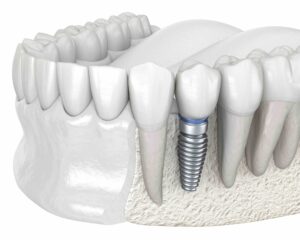
Periodontists receive extensive training, including three additional years of education beyond dental school. They are able to treat more problematic periodontal cases, such as people with severe gum disease or those having a complex medical history.
In addition, a periodontal specialist is trained in performing cosmetic procedures that involve gum tissues, such as correcting a “gummy smile”.
It is a busy specialty. It is estimated that over 47 percent of American adults have some level of periodontal disease (also known as “gum disease”). Because this disease can begin without obvious warning signs, many are unaware of its presence.
Gum disease begins with gingivitis, with some symptoms that may be easily ignored. However, when symptoms involve discomfort, the disease can be approaching more advanced levels.
This is why it is important to be familiar with the signs and symptoms, which include:
• Red, swollen or tender gums or other pain in your mouth
• Bleeding while brushing, flossing, or when eating certain foods
• Gums that are receding (pulling away from the teeth) or make the appear teeth longer than normal
• Loose or separating teeth
• Pus between your gums and teeth
• Sores in your mouth
• Persistent bad breath
• A change in the way your teeth fit together when you bite
• A change in the fit of partial dentures
If you notice any of these symptoms, be sure to contact your dentist or periodontist without delay. Gum disease will only worsen without treatment. It is the nation’s leading cause of adult tooth loss.
For specialized needs, we offer an advanced care environment where patients are comfortable and experience a restoration of their smiles with the support of advanced technology. These features include:
• LANAP Protocol Using PerioLase MVP-7 – Efficiently and effectively treats periodontitis (advanced gum disease) with laser technology. It causes very little discomfort and has a quick recovery time. This has also been found to stimulate bone regrowth in damaged areas.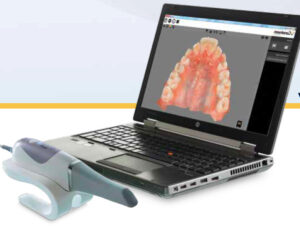
• Dental Radiology With 3-D Cone Beam Technology – This imaging is ideal for diagnosis and treatment planning. The imaging covers the entire dentition area with clear views of the mandible and maxilla (upper and lower jaw).
• CareStream Cone Beam Computer Tomography Imaging – This computerized tomography provides imaging in exceptional detail and range.
• CS 3600 intraoral scanner – Patients no longer have to endure having impressions made with bulky, glopy trays held in their mouths! This quickly and comfortably scans the mouth’s interior for digital impressions using a small, handheld scanner. It can also reach difficult–to–access areas in the patient’s mouth with improved patient comfort.
• Simplant Dental Software for Computerized Dental Implant Placement – This system helps in pre-surgical positioning of dental implants on the computer, using a 3D model of the patient’s jaw. This aids in the selection of the implant type that ensures a precision fit.
• Intraoral Camera Technology – This provides outstanding quality of images within the mouth. These images are sent to screen for a clear, crisp view so we can confer with patients on specific treatment issues.
• Computer Imaging In Treatment Suites – Treatment suites are equipped with computers for convenient image sharing with patients.
• Advanced Sterilization – Our custom sterilization unit adheres to (or exceeds) CDC guidelines for instrument processing protocols, particularly in the cleaning of instruments.
• Fully-Equipped Surgical Suites – Relax during treatment while surrounded by beautiful mountain views of Asheville.
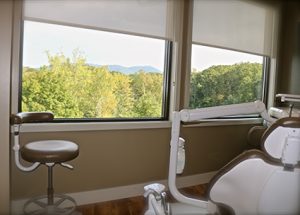 Periodontal (gum) disease is the result of an accumulation of oral bacteria and the leading cause of adult tooth loss. Have you avoided seeing a dentist for years? You are not alone. An estimated 70 percent of adults admit to having some level of anxiety or fear associated with dental care.
Periodontal (gum) disease is the result of an accumulation of oral bacteria and the leading cause of adult tooth loss. Have you avoided seeing a dentist for years? You are not alone. An estimated 70 percent of adults admit to having some level of anxiety or fear associated with dental care.
Our office is structured to attend to your specific needs, gently and respectfully. We offer a private consultation room to discuss treatment in a comfortable setting versus communicating with patients while they are seated in a treatment chair.
For patients who desire a “sleep” state, we offer oral sedation as well as I.V. sedation (twilight sleep). Oral sedation is a pill that helps patients relax. It also has an amnesiac effect, leaving most with little or no memory of treatment afterward.
I.V. sedation places the patient in a deeper sedative state (twilight sleep), also erasing memory of the procedure. It is administered by a doctor of anesthesiology for optimal comfort and safety.
With both, patients are monitored with advanced safety equipment throughout treatment.
Patients also find our entire staff to be a unified team, each bringing a sincere level of compassion and commitment to excellent care.
For people in need of gum recontouring, a periodontist is THE expert in the shaping of oral gum tissues. Here, Dr. Jennifer Boyland and I have advanced training to create gum tissue contours with a natural appearance. We are also able to ensure healthy seals around teeth to protect the structures beneath the gums from bacteria penetration.
Our specialty is ideal for those who have a “gummy smile.” This is when too much gum tissue shows above upper teeth most visible in a full smile. While this trait does not interfere with the ability to have and maintain a healthy smile, for many, it causes them to ‘hold back’ rather than smile fully. Some people cover their smiles with a hand or try to smile with lips only.
Gum re-contouring is also done in crown lengthening procedures. This evens out the amount of gum tissues that arch teeth for a beautiful, balanced smile line.
Having healthy gums is so important. As research continually shows, gum health is intricately connected to overall health. Oral bacteria of periodontal disease has been linked as a trigger for serious diseases, including heart disease, some cancers, stroke, memory loss, diabetes, and arthritis.
If you are experiencing any of the symptoms associated with periodontal disease, a referral is not required. Call 828-274-9440 and we will be happy to assist you.
Recent Posts
Categories
Archives
- September 2024
- August 2024
- July 2024
- June 2024
- May 2024
- April 2024
- March 2024
- February 2024
- January 2024
- December 2023
- November 2023
- October 2023
- September 2023
- August 2023
- July 2023
- June 2023
- May 2023
- April 2023
- March 2023
- February 2023
- January 2023
- December 2022
- November 2022
- October 2022
- September 2022
- August 2022
- July 2022
- June 2022
- May 2022
- April 2022
- March 2022
- February 2022
- January 2022
- December 2021
- November 2021
- October 2021
- September 2021
- August 2021
- July 2021
- June 2021
- May 2021
- April 2021
- March 2021
- February 2021
- January 2021
- December 2020
- November 2020
- October 2020
- September 2020
- August 2020
- July 2020
- June 2020
- May 2020
- April 2020
- March 2020
- February 2020
- January 2020
- December 2019
- November 2019
- October 2019
- September 2019
- August 2019
- July 2019
- June 2019
- May 2019
- April 2019
- March 2019
- February 2019
- January 2019
- December 2018
- November 2018
- October 2018
- September 2018
- August 2018
- July 2018
- June 2018
- May 2018
- April 2018
- March 2018
- February 2018
- January 2018
- December 2017
- November 2017
- October 2017
- September 2017
- August 2017
- July 2017
- June 2017
- May 2017
- April 2017
- March 2017
- February 2017
- January 2017
- December 2016
- November 2016
- October 2016
- September 2016
- August 2016
- July 2016
- June 2016
- May 2016
- April 2016
- March 2016
- February 2016
- January 2016
- December 2015
- November 2015
- October 2015
- September 2015
- August 2015
- July 2015
- June 2015
- May 2015
- April 2015
- March 2015
- February 2015
- January 2015
- December 2014
- November 2014
- October 2014
- September 2014
- August 2014
- July 2014
- June 2014
- May 2014
- April 2014
- March 2014
- February 2014
- January 2014
- December 2013
- November 2013
- October 2013
- September 2013
- August 2013
- July 2013
- June 2013
- May 2013
- April 2013
- March 2013
- February 2013
- January 2013
- December 2012
- November 2012
- October 2012
- September 2012
- August 2012
- July 2012
- June 2012


